It’s super important to choose the right Google Ads bid strategy and have a solid plan for adjusting your bids if you want to save money on advertising.
If you don’t know what you’re doing, you might blow your entire budget on just a few clicks. But if you make smart choices, you can seriously boost the effectiveness of your campaign.
Have you ever considered that simply tweaking your bidding strategies could lead to a mind-blowing 196.41% increase in click-through rates and a whopping 142.86% boost in conversions? It’s true!
If you’re interested in achieving this kind of results, keep reading and uncover the most optimal Google Ads bidding strategies to use for your business.
Table of Contents
What Is Google Ads?
Google Ads, previously known as Google AdWords, is an internet advertising platform that revolves around a bidding system. It offers a wide range of ad formats including search engine ads with text, video ads, banner ads, and even ones on YouTube, along with other display options. These ads can be seen on Google search results and many websites that are connected to Google.
The Google Ads system uses the same technology that powers Google Search to place ads in front of people who are interested in your products and services when they are searching for related terms on Google.
Google Ads bidding strategies are designed to help you reach your business goals as effectively as possible.
But choosing a strategy that matches your goals and budget best is up to you.
How Does Google Ads Work?
The way Google ads work is pretty simple. You make an ad, decide how much you’re willing to pay, and then wait for the sales to roll in. But there are important things to keep in mind.
We’ll go into the detailed strategies in the next section. But the basic idea is that you pay for each action someone takes on your ad.
Google Ads Bidding Strategies to Boost Conversions
Below we will cover each of the 11 winning Pay-Per-ClickPPC strategies. Plus, we will offer insights into how to use them effectively, and when they work best, and providing extra tips to maximize the benefits of using these.
1. Target CPA (Cost Per Action)
Target CPA (Cost Per Action) bidding is a “Google Ads bidding strategy that uses automation to set bids to achieve the highest number of conversions or desired customer actions.
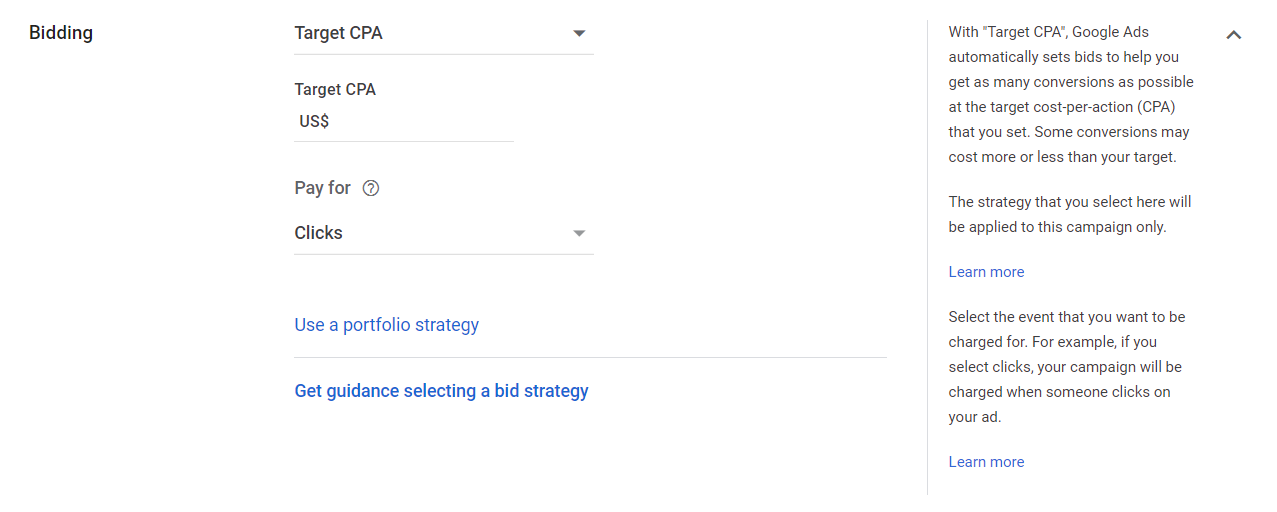
By selecting the Target CPA (cost-per-action) bid strategy, you can indicate the average cost per conversion you prefer. Google Ads will then use this Target CPA to calculate bids, considering the likelihood of an ad resulting in a conversion.
However, it is important to note that the outcome of your desired cost per acquisition (CPA) may not always match the initial number you set. It could be lower, higher, or even the same. Additionally, if your target CPA is set too low, there is a possibility that Google may not display your ads at all.
When To Use The Target CPA Bidding Strategy?
It is better to use this strategy in case you have clear CPA goals and know the value of each conversion for your business. Additionally, if you have been employing a different bidding strategy and wish to compare the CPAs associated with each strategy, you may also consider giving this strategy a try.
Note: Google suggests reviewing your budget settings and making sure you are comfortable if it spends up to 2x your average daily budget. However, Google assures that they will not surpass your monthly charging limit.
Tip: You have the option to select which conversions you want to bid for. By using the “Include in Conversions” setting, you can decide whether or not to include specific conversion actions in your reporting columns for “Conversions” and “Conversion value”. These columns are utilized by bid strategies such as Target CPA, Target ROAS, and ECPC. It ensures that your bid strategy optimizes based on the conversions you have chosen to include.
2. Target ROAS (Return On Ad Spend)
The Target ROAS strategy focuses on maximizing the value derived from advertising expenses by allowing you to set a specific target for the return you aim to achieve on each dollar spent. The algorithm of the platform then adjusts bids dynamically to optimize for conversions that align with the specified ROAS goals.

By leveraging the power of data-driven insights and machine learning, Target ROAS aims to enhance advertising campaigns’ overall efficiency and effectiveness, ensuring that ad spending is allocated to activities that deliver the highest possible return on investment.
The Target ROAS, one of the most profit-driven bid strategies in Google Ads, is expressed as a percentage. To calculate it you need to divide your sales by your ad spend and then multiply by 100%. The formula looks as follows:
sales / ad spend X 100 = return on ad spend
For example, if you want to make $4 for every $1 you spend, your ROAS equals 400%.
sales / ad spend X 100 = return on ad spend (4 / 1) X 100 = 400% ROAS
When To Use The Target ROAS Bidding Strategy?
This strategy is particularly useful for businesses with diverse products or services, each with varying profit margins, as Target ROAS accommodates different return expectations. So it’s mostly beneficial for eCommerce stores and for businesses that have defined conversion value for each conversion.
Note: To utilize Target ROAS bidding, the majority of campaign types require a minimum of 15 conversions within the preceding 30-day period. Campaigns that meet this requirement will be automatically approved for Target ROAS.
Tip: If historical performance is available for you, check out the Recommendations page in your account and follow the recommended target.
3. Maximize Conversions
The Maximize Conversions bidding strategy is a dynamic and automated approach employed to help you achieve the highest possible number of conversions within a given budget. In this strategy, you set a daily budget, and Google Ads uses advanced machine learning algorithms to automatically adjust bids in real time, aiming to maximize the overall number of conversions.
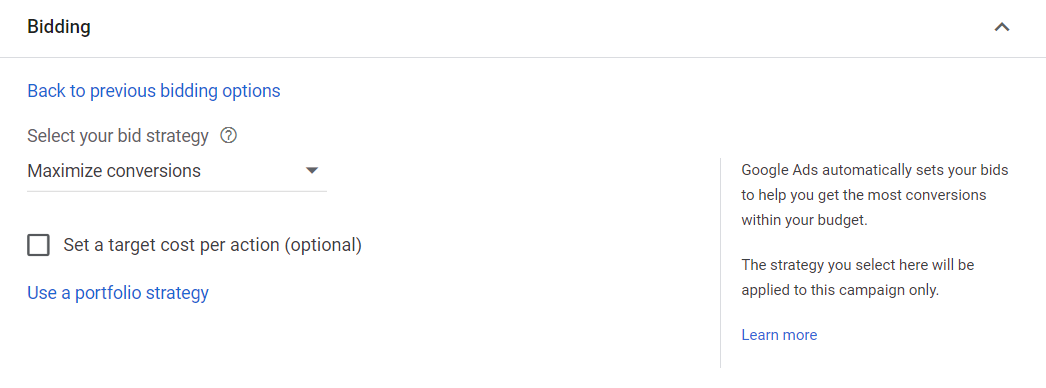
If your budget is limited, it is advisable to begin with a lower daily budget and observe the results. Gradually increasing your daily budget will allow you to assess if there is an increase in conversions. In doing so, Google will strive to maximize the number of conversions achieved.
When To Use the Maximize Conversions Bidding Strategy?
This bidding strategy in Google Ads is recommended if all of your conversions hold equal value and you do not have specific goals for return on ad spend (ROAS) or cost per acquisition (CPA). For instance, if you are selling a course, a membership program, or event tickets with consistent pricing.
Note: Google suggests using the budget simulator and impression share metrics to assess the potential budget for your campaign when using Maximize conversions bidding. This recommendation is specifically applicable when you are not utilizing Maximize conversion strategies with Target CPA or Target ROAS settings.
Tip: If you want to get cost-effective conversions, you should set a Target CPA on your Maximize Conversions bidding strategy. While the Maximize Conversions bidding strategy prioritizes maximizing the number of conversions, it does not inherently optimize costs for each action and may utilize your entire budget.
4. Maximize Conversion Value
With Maximize Conversion value, one of the most popular Google Ads bidding strategies, Google will try to get conversions that have the highest value for your business. Opposite to the Maximize Conversion bidding strategy that focuses on the number of conversions, this strategy focuses on the quality (or value) of them. So, you set a daily budget, and the system aims to allocate bids where they are likely to generate the most significant revenue.

This strategy may involve bidding higher in auctions that have the potential for greater conversion value compared to auctions with lower conversion value.
When To Use the Maximize Conversion Value Bidding Strategy?
This strategy is particularly beneficial for businesses with diverse products or services that carry varying values, as it optimizes ad placements to attract users more likely to make high-value conversions. Implementing
If your business offers different products and price points to your customers. You would like to use this bidding strategy if your goal is to drive conversions to your most expensive and most profitable products. eCommerce businesses are a great fit for this AdWords bid strategy.
Note: Maximize Conversion Value bidding strategy is only available for Search campaigns and Smart Shopping campaigns.
Tip: Maximize Conversion Value bidding strategy will try to spend your whole average daily budget and increase your ad spend. To avoid this, check your average daily budget and set a target ROAS goal.
5. Enhanced CPC (Cost Per Clicks)
While other Smart Bidding strategies don’t require you to set bids manually and fully automate your bid strategy considering your CPA, ROAS, or budget target, ECPC (Enhanced Cost Per Click) partially automates your manual bids. In both cases, the goal is to get more conversions (quantity) or higher conversion value (quality).

In other words, Enhanced CPC is a bidding strategy combining manual bidding with automated features. It is aimed to improve the performance of individual bids during real-time auctions. You can maintain control over their bids by setting maximum CPC limits. However, the system will adjust these bids based on the likelihood of a click leading to a conversion. By utilizing historical campaign data and machine learning algorithms, Enhanced CPC optimizes bids for clicks that have a higher probability of resulting in valuable user actions, such as purchases or sign-ups.
When To Use the ECPC Bidding Strategy?
Among all Google Ads bidding strategies advertisers use this one when they already have some conversion data but not it’s not enough for using one of the Smart bidding strategies. To use any of the Smart bidding strategies, advertisers should have at least 30 conversions in the last 30 days. If the available data is below minimum requirements, advertisers should use ECPC as a temporary PPC bidding strategy.
Note: Enhanced CPC is no longer supported for Shopping campaigns. Since early October 2023, Google has gradually transitioned Shopping campaigns that utilize ECPC to manual bidding.
Tip: The ECPC bidding strategy takes into account the conversion rates for various types of traffic, but it applies different bids specifically for mobile devices. Therefore, to optimize conversions, you only need to adjust bids for mobile. However, if you want to pay more for a particular type of traffic, you have the option to set a bid adjustment.
6. Maximize Clicks
The Maximize clicks bidding strategy uses machine learning algorithms to modify bids in real-time, taking into account the probability of generating clicks. You need to establish a daily budget, and the system will distribute bids across different auctions intending to maximize the total click volume.
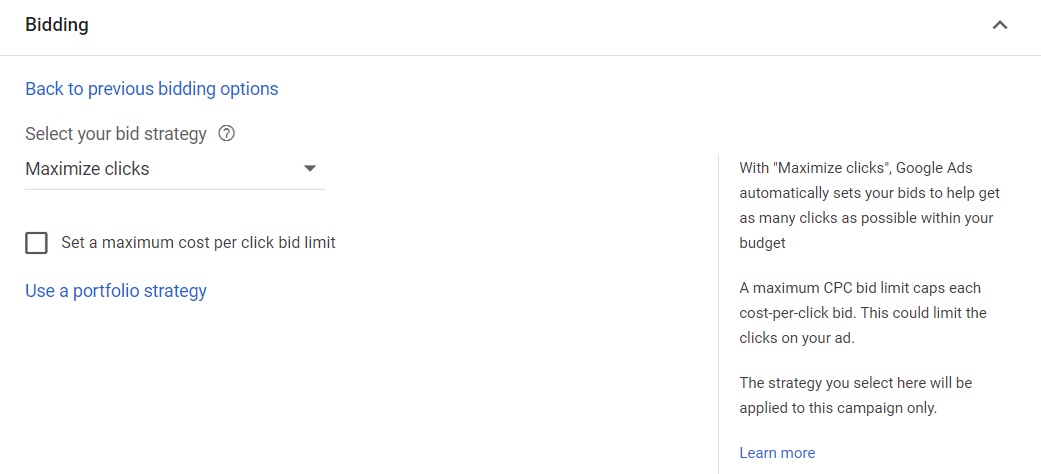
In other words, this Google Ads bidding strategy helps you get as many clicks as possible. It’s one of the Google Ads bidding strategies that aim at increasing your brand awareness and web traffic and might be a fit good for a business with a large budget.
When To Use the Maximize Clicks Bidding Strategy?
The Maximize Clicks strategy is especially advantageous for campaigns that aim to generate website traffic without focusing on conversions. Although it offers a hands-off approach to bid management, you need to closely monitor performance to ensure that the higher number of clicks aligns with their campaign objectives and that the quality of clicks remains satisfactory. So, you can use this strategy once your business has a well-optimized landing page with a strong CTA and you want to get as many eyeballs to your offer as possible. Or if you simply want to increase your website traffic.
Note: Paying for clicks might not be logical since clicking an ad does not guarantee conversion. Google will charge you for visitors who are not qualified, resulting in a lack of valuable returns.
Tip: You can add a Maximum CPC (cost per click) bid limit to your Maximize Clicks bid strategy. It will allow you to define the maximum amount you are ready to pay for each click. Failing to set a limit will result in Google adjusting your bids.
7. Manual CPC (Cost per click)
Manual CPC (Cost Per Click) bidding is one of those Google Ads bidding strategies that allow setting a maximum CPC for your ads (keywords, ad group, campaign). That’s the maximum amount you are ready to pay for each click. This strategy allows for precise bid adjustments at the keyword or ad group level, enabling advertisers to allocate budgets based on their strategic priorities.
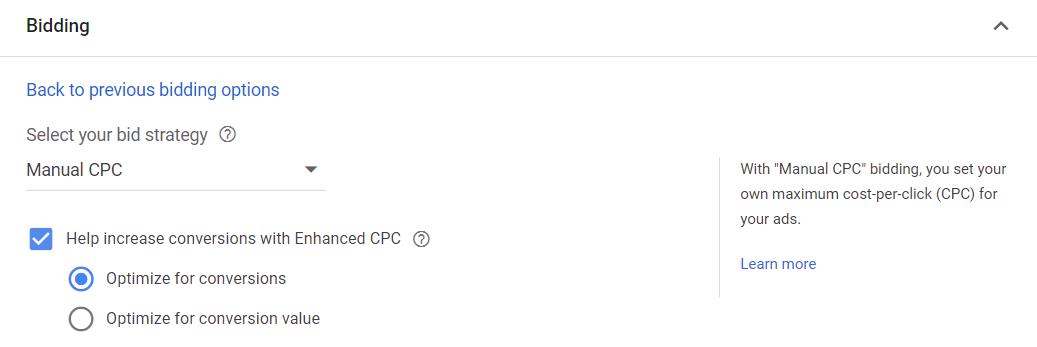
When To Use the Manual CPC Bidding Strategy?
The Manual CPC Google Ads bidding strategy is especially beneficial to use in the following cases:
- If you want to have full control over your keyword bids.
- If you have available time to check and manually adjust your keyword bids.
- If your account doesn’t have at least 30 conversions in the past 30 days and you can’t use a Smart Bidding strategy.
Note: In case your bids are too low, Google might not serve your ads to users and you might lose potential customers.
Tip: In the beginning, you can set a maximum CPC bid for your entire ad group. Once you notice that some keywords are more profitable, you can allocate more of your budget to those keywords.
8. Target CPM (Cost Per Mille/Thousand Impressions)
The Target CPM (Cost Per Mille/Thousand Impressions) bidding strategy is designed for advertisers looking to maximize their ad visibility and brand exposure.
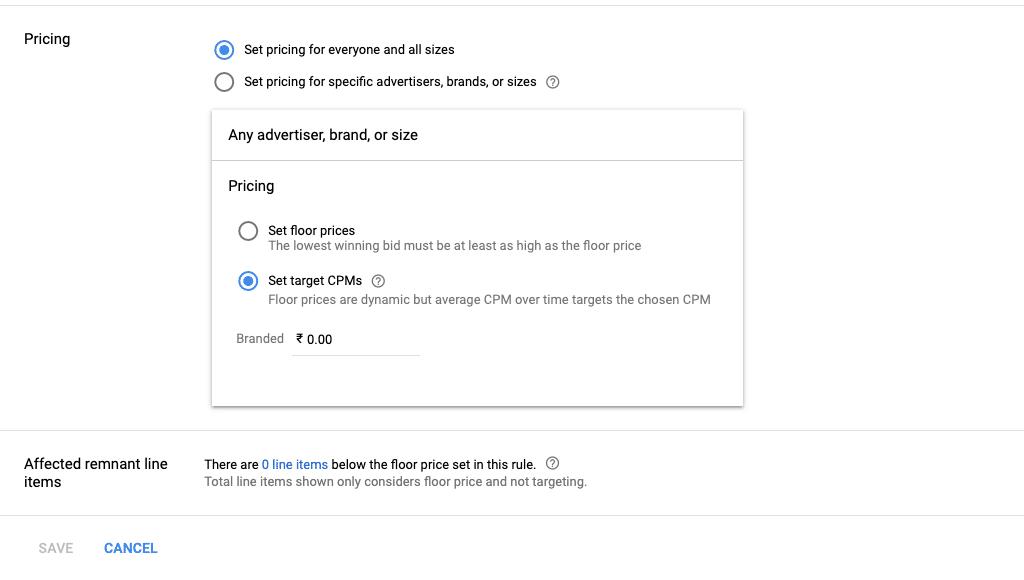
With this bidding strategy, you pay per thousand impressions. You don’t pay for anyone who skips out your ad and this strategy usually comes out fairly cheap. However, this is one of Google Ads’ bidding strategies that focus on vanity metrics as impressions don’t always lead to conversions and sales but you are charged to be seen.
When To Use the Target CPM Bidding Strategy?
Target CPM is ideal for advertisers prioritizing impressions over specific user actions, expanding brand reach for broad awareness rather than immediate conversions. This approach is valuable for establishing a strong brand presence as a primary objective. If your business plans to advertise on Google Display Network or YouTube, consider using Target CPM to boost brand awareness effectively.
Note: This bidding strategy is not available for the Search network.
Tip: Try to keep your video ads below 15 seconds and communicate your message quickly as users aren’t likely to watch a 30-second ad.
9. Viewable CPM (Cost Per Mile)
Google’s Viewable CPM (Cost Per Mille) strategy is designed to optimize ad impressions by charging advertisers based on the number of viewable impressions, where an impression is counted only if a significant portion of the ad is visible on the user’s screen. This strategy aims to enhance the visibility and engagement of ads, ensuring that advertisers pay for impressions that are more likely to be seen by the audience.

Out of all Google ads bidding strategies, Viewable CPM requires you to pay only for 1,000 impressions that are considered “viewable”. It means that users see 50% of your display ads on screen for 1 or more seconds or if your video ad plays 2 or more seconds.
When To Use The Viewable CPM Value Bidding Strategy?
As in the case of the CPM bidding strategy, this one also works mainly for brand awareness campaigns. If your goal is to increase your conversion rate, ROAS, or conversion value and you plan to run a profit-driven campaign, you should skip this Google ads bid strategy.
Note: This strategy isn’t available for Search Network-only campaigns.
Tip: If you want to proceed with this bidding strategy, make sure your ads are compatible. Otherwise, your ads won’t run.
10. Cost Per View (CPV)
The CPV (Cost Per View) strategy is on the list of Google Ads bidding strategies that are awareness-driven instead of conversion-driven and profit-driven.
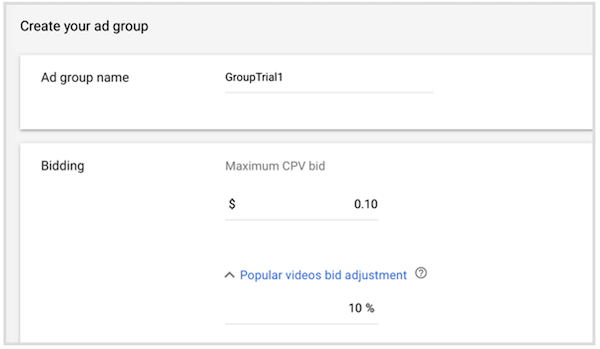
This is a video advertising bidding model where you need to pay for video views or interactions rather than clicks. In this approach, you set a maximum CPV bid, representing the highest amount you are willing to pay for a view of your video ad.
If the user watches your video for 30 seconds (or the whole video if it’s shorter), that’s counted as a “view”. The maximum CPV bid is the highest amount you are ready to pay for a view or click.
When To Use The CPV Bidding Strategy?
CPV offers unique advantages for campaigns that focus on videos and aim to increase brand awareness or engagement. Google charges you only when viewers watch 30 seconds of your video. This approach is ideal for businesses that want to convey their message through compelling visual storytelling and engaging video content. Particularly on platforms like YouTube where CPV can optimize the reach and impact of video campaigns. Opting for CPV is a strategic decision when the main objective is to captivate and connect with the audience through video content, measuring success based on views and user engagement rather than traditional click-through rates. Alternatively, you can use the CPM bidding strategy. However, you’d rather pay for a 30-second video view or click than for a 2-second video view.
Note: The cost-per-view metric in reporting only takes into account the cost that was eligible for views. Certain ad formats, such as bumper ads or non-skippable in-stream ads, do not qualify for views.
Tip: The actual CPV is the final amount you pay for a view. It’s often less than your maximum CPV. Quality Score and Ad Rank are two essential elements that affect your actual CPV. Quality Score shows how relevant your ad is for users, while Ad Rank is your Quality Score multiplied by your maximum CPV bid.
11. Target Impression Share
The Target Impression Share bidding strategy is specifically created for advertisers who aim to maximize their advertisement visibility on the search engine results page. Under this strategy, you can set a preferred ad impression percentage, aiming for positions like the top or absolute top.
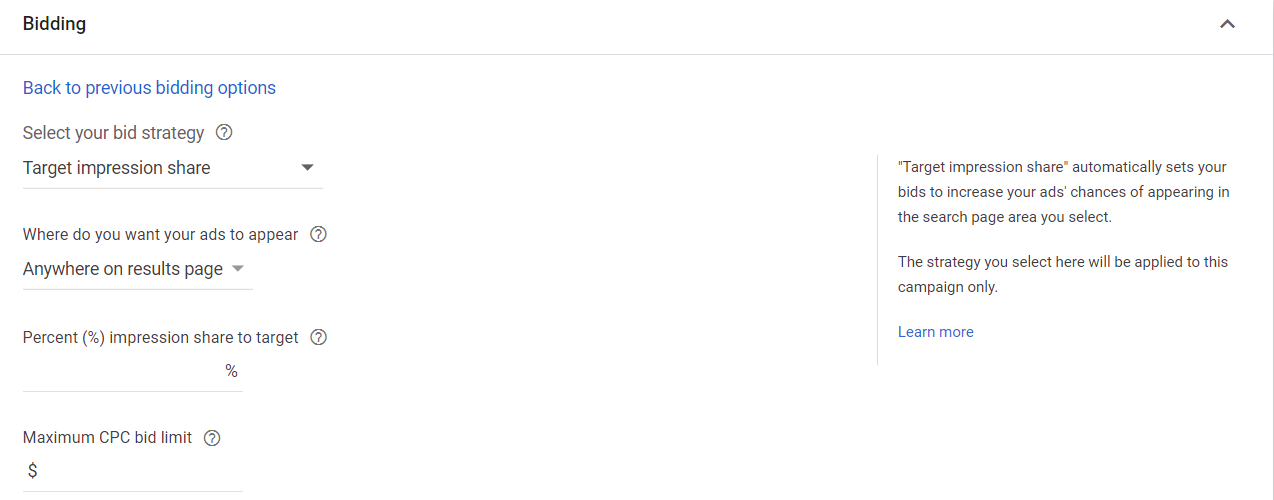
You can also choose where Google will show your ads: on the absolute top of the page, on the top of the page, or anywhere on the page of Google search results.
When To Use The Target Impression Share Bidding Strategy?
You should use this Google Ads bidding strategy especially when bidding on branded terms. In this case, you want to make sure that searches will see your ad 100% of the time. So you set the Target Impression Share to 100%.
You might also want to use this bidding strategy if you have a large budget and would like to increase brand awareness.
Last but not least, this is a great defensive strategy against your competitors if they are bidding on your branded keywords and want to steal your potential customers.
Note: Impression share solely encompasses the Google Search Network, excluding any Search Partners.
Tip: Make sure not to set your Max CPC limit bid too low. Otherwise, it might hold you back from reaching your Target Impression Share goal.
Choose the Right Google Ads Bidding Strategy with Andava
Choosing the correct AdWords bid strategy and configuring your campaign accurately is crucial. Familiarity with Google Ads’ technical aspects is necessary for optimal ad performance.
Andava provides Google Ads management services. We have seen thousands of campaigns succeed with the help of lesser-known best practices, tips, and secrets.
We will help you choose the ideal Google Ads bidding strategies for your campaigns and keep your ad costs down while increasing your conversions and ROAS.
Choose the Right Google Ads Bidding Strategy with Andava
Selecting the appropriate bidding strategy and properly setting up your campaign are both crucial. It is important to have a good understanding of the technical aspects of Google Ads. This will ensure that your ads perform as expected.
At Andava, we offer Google Ads management services. Through our experience, we have witnessed numerous successful campaigns that have benefited from lesser-known best practices, tips, and secrets. Our team will help you choose the right Google Ads bidding strategies to lower ad costs and boost conversions and ROAS.